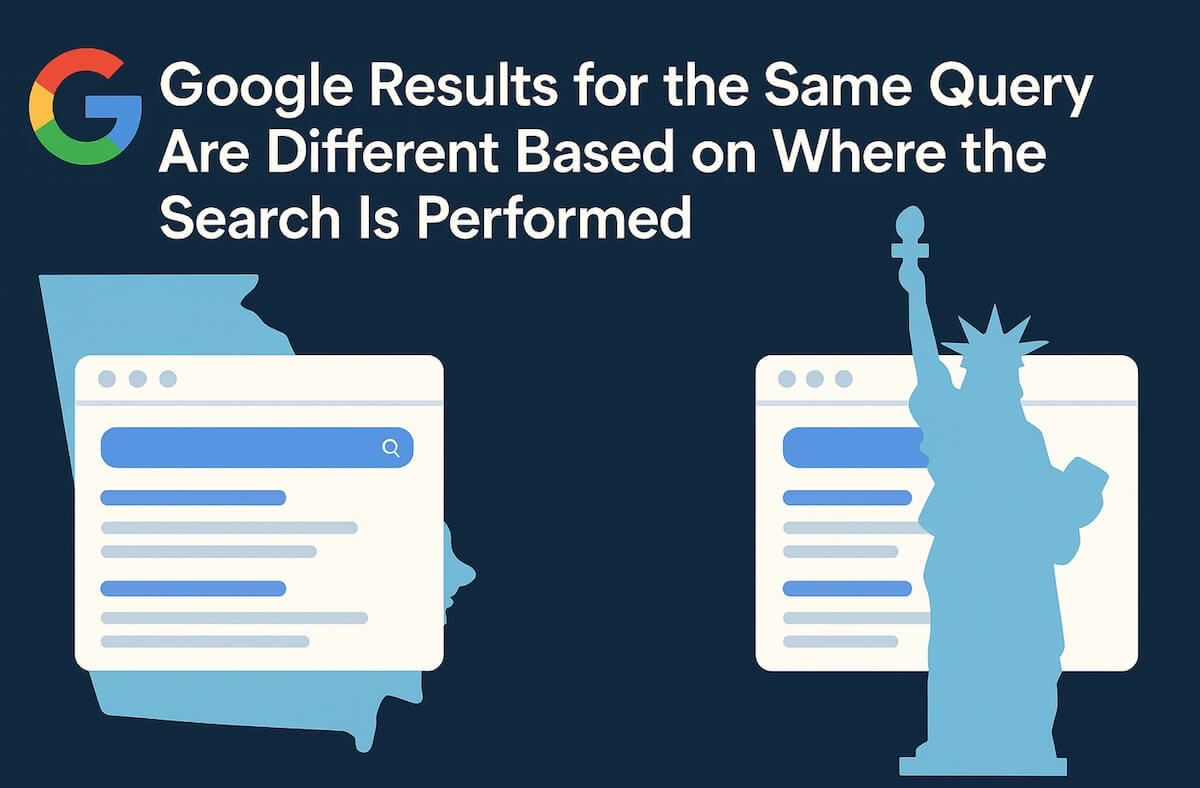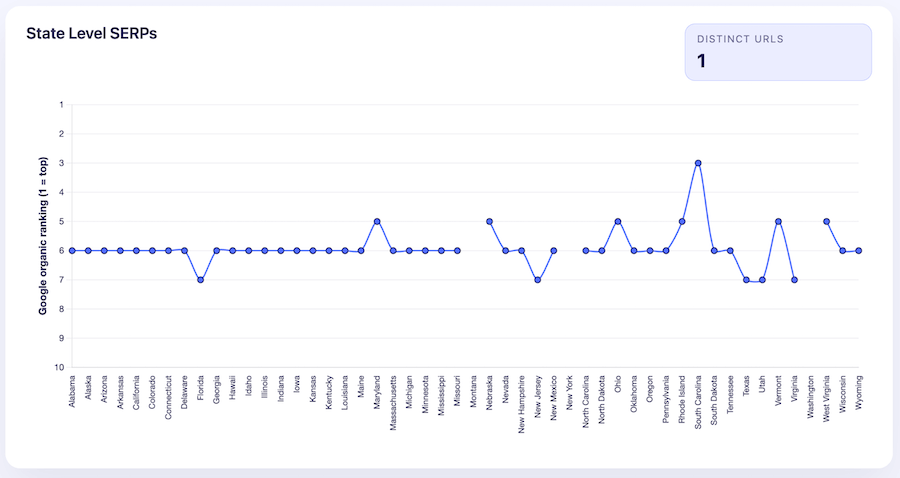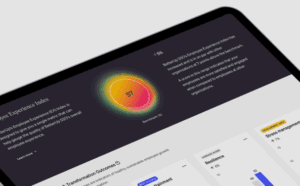Home / Blog / Location-Based Search Results: How Geographic Targeting Changes Google Rankings
Location-Based Search Results: How Geographic Targeting Changes Google Rankings
Published: October 24, 2025
Share on LinkedIn Share on Twitter Share on Facebook Click to print Click to copy url

Contents Overview
A comprehensive study revealing how Google’s location-based algorithm personalizes search results based on geographic signals, and what it means for your local SEO strategy.
What We Discovered About Local SERPs
Understanding how Google personalizes search results based on location is critical for modern SEO strategy. Our geo-personalization study analyzed a single high-value keyword across all 50 U.S. states and their largest cities, revealing dramatic visibility shifts based on how specific Google’s location signal becomes.
Key findings:
- 50% drop in visibility when moving from state-level to city-level searches
- Geographic signals triggered different landing pages in 40% of locations
- Only 6% of city searches improved rankings compared to state-level results
- Three major metros showed zero page-one visibility regardless of location specificity
These patterns reveal why traditional rank tracking fails to capture true performance and why location-specific content strategy is no longer optional.
Study methodology note: This represents a qualitative snapshot from a single crawl across all locations in October 2025. While Google’s SERPs shift hourly, these patterns consistently mirror ongoing geo-personalization behavior we’ve observed: tighter geographic signals fundamentally reshuffle both page selection and ranking positions.
Research Methodology: Testing Geographic Search Personalization
To understand how location signals impact search visibility, we designed a controlled experiment measuring Google’s response to varying levels of geographic specificity.
Data Collection Parameters
- Search API: Google Web Search via SerpApi Search API
- Target keyword: Single high-volume head term (methodology-focused to ensure broad applicability)
- Geographic scope: All 50 U.S. states with dual location profiles:
- State-level signal (e.g., “Georgia, United States”)
- Metro-level signal using each state’s largest city (e.g., “Atlanta, Georgia, United States”)
- Total SERPs analyzed: 100 distinct search results pages (50 states × 2 location types)
Tracking Metrics
We measured three critical ranking factors for our test publisher:
- Page-one visibility (yes/no presence in top 10 organic results)
- Ranking URL (which specific landing page Google selected)
- Organic position (numerical ranking from 1-10)
Timeline
All 100 queries executed consecutively in October 2025, representing a synchronized snapshot of Google’s location-based ranking algorithm at a single point in time.
Geographic Search Results: What the Data Reveals
Our analysis uncovered four major patterns in how Google’s location signals affect search visibility: massive visibility drops in city-specific searches, systematic page substitution, ranking position volatility, and complete invisibility in certain high-value markets.
When the location was set to just the state level we found a single URL ranked in almost the identical position across all 50 states.

However, when we performed the same search with a location set to the largest city in each state, the SERPs changed significantly in both ranking position and which pages were selected.

The Visibility Cliff: State vs. City Rankings
The most striking finding: location specificity dramatically reduces search visibility.
- State-level searches: 94% page-one visibility (47 of 50 states)
- City-level searches: 46% page-one visibility (23 of 50 cities)
- Net visibility loss: 24 cities (48%) completely dropped the publisher from page one despite strong state-level rankings
Landing Page Substitution
Google didn’t just change rankings—it changed which pages appeared:
- 20 locations (40%) triggered complete URL swaps, with Google favoring state-specific landing pages over the national hub
- This happened even when rankings declined, suggesting Google prioritizes perceived local intent over ranking strength
Position Volatility Across Geographic Signals
- 19 states experienced ranking position shifts between state and city SERPs
- Only 3 cities (6%) improved rankings: Atlanta, Chicago, and Detroit
- 16 cities saw rankings decline when location signals became more specific
Complete Invisibility in Major Markets
Three metros delivered zero page-one visibility regardless of location signal strength:
- Billings, Montana
- New York City, New York
- Seattle, Washington
The absence in high-population markets like NYC and Seattle signals intense local competition and Google’s strong preference for hyperlocal content in these geographies.
Case Study: Cities That Eliminated Page-One Rankings
In 24 cities, nearly half of all metros tested, Google completely removed the publisher from page one despite strong state-level performance. This represents the most severe form of location-based ranking volatility.
Cities with Complete Visibility Loss
Major markets experiencing total page-one removal include:
Southern Markets:
- Birmingham, Alabama
- Jacksonville, Florida
- Jackson, Mississippi
- Nashville, Tennessee
- Houston, Texas
Midwestern Markets:
- Indianapolis, Indiana
- Omaha, Nebraska
Northeastern Markets:
- Baltimore, Maryland
- Providence, Rhode Island
Western Markets:
- Anchorage, Alaska
(Plus 14 additional cities—see full data for complete list)
Why This Matters for Local SEO
This pattern reveals Google’s algorithmic bias toward hyperlocal relevancy signals in metropolitan areas. When location signals become city-specific, Google appears to:
- Elevate local competitors with stronger city-level content signals
- Devalue broad, state-level content that lacks metro-specific context
- Require deeper local intent coverage to maintain visibility in competitive urban markets
For SEO strategists, this means state-level content alone is insufficient for major metro visibility.
Case Study: When Google Swapped National Content for Local Pages
Perhaps the most fascinating pattern: even when visibility persisted, Google often chose completely different landing pages based on location signals. In 20 states (40% of all locations), Google substituted the national hub for state-specific content.
Examples of URL Substitution
| State | City | What Happened | Position Change |
|---|---|---|---|
| Arizona | Phoenix | National hub → Arizona state guide | 6 → 9 (dropped 3) |
| California | Los Angeles | National hub → California state guide | 6 → 8 (dropped 2) |
| Colorado | Denver | National hub → Colorado state guide | 6 → 7 (dropped 1) |
| Arkansas | Little Rock | National hub → Arkansas state guide | 6 → 6 (same) |
| Connecticut | Bridgeport | National hub → Connecticut state guide | 6 → 7 (dropped 1) |
(Plus 15 additional state → city transitions)
The Local Intent Signal
This behavior reveals Google’s sophisticated understanding of inferred user intent:
- State-level searchers see broader, national content
- City-level searchers trigger Google’s local intent filter, surfacing state-specific pages even when rankings decline
- Geographic relevance trumps ranking strength in Google’s page selection algorithm
The algorithm assumes that users searching from specific cities want locally-relevant answers, even if more authoritative national content exists.
The Rare Wins: When Local SEO Actually Improved Rankings
While most cities either lost visibility or experienced ranking declines, three major metros demonstrated the power of well-executed local content strategy. These markets rewarded localized landing pages with significant ranking improvements.
Cities with Improved Rankings
| State | City | State-Level Rank | City-Level Rank | Improvement | Page Type |
|---|---|---|---|---|---|
| Georgia | Atlanta | 6 | 3 | +3 positions | State-specific guide |
| Illinois | Chicago | 6 | 3 | +3 positions | State-specific guide |
| Michigan | Detroit | 6 | 3 | +3 positions | State-specific guide |
What Made These Cities Different
Each winning metro shared key characteristics:
- Strong local content signals – State-specific guides with unique local data and context
- Consistent 3-position jump – All three markets moved from mid-page (#6) to top-half visibility (#3)
- Major population centers – Atlanta, Chicago, and Detroit represent high-value, competitive markets
- Geographic relevance alignment – The content matched what Google inferred users wanted based on their city location
These wins prove that location-targeted content can dramatically improve rankings when executed correctly—but the opportunity is rare and requires substantial local optimization.
Markets with Zero Visibility: The Hardest SEO Challenges
Three metros stood out for the wrong reasons: complete absence from page one regardless of whether the location signal was broad (state-level) or specific (city-level).
The Invisible Markets
- Billings, Montana – No visibility (state or city)
- New York City, New York – No visibility (state or city)
- Seattle, Washington – No visibility (state or city)
Why These Markets Proved Impenetrable
The total invisibility in these locations reveals different challenges:
High-Competition Metro Markets (NYC & Seattle):
- Intense local competition from established brands with deep local authority
- Google’s strong preference for hyperlocal content in major tech and finance hubs
- Higher content quality bar for ranking in sophisticated urban markets
- Competitors likely using advanced local SEO strategies (schema, citations, local link building)
Low-Population Markets (Billings):
- Different local search intent patterns in smaller metros
- Potential mismatch between keyword intent and local searcher needs
- Competitors may have stronger regional authority despite smaller market size
These zero-visibility metros represent the extreme ends of the local SEO difficulty spectrum.
Why Geographic Search Personalization Matters for Your SEO Strategy
These findings expose critical gaps in how most organizations approach search visibility and content strategy.
1. Your Rank Tracking May Be Lying to You
The problem: Traditional rank tracking efforts may focus on state-level positions that don’t reflect what real users in major cities actually see.
Real-world impact:
- A “#6 in Georgia” ranking tells you nothing about Atlanta visibility (which jumped to #3 in our study)
- Houston showed state-level ranking but zero city visibility
- 48% of cities saw complete ranking elimination despite strong state performance
What to do: Implement location-specific rank tracking for every major metro where you have business goals. A single keyword requires tracking across 50+ distinct geographic signals to capture true performance.
2. National Content Strategies Fail in Local Markets
The problem: Broad, national content performs well in state-level searches but gets crushed when Google detects city-specific user location.
Real-world impact:
- 40% of locations triggered complete URL swaps favoring local pages
- Google prioritizes geographic relevance over content authority
- Metro searchers see different pages even when national content ranks higher
What to do: Build comprehensive location-specific landing pages with unique local value but be sure to avoid just creating thin doorway pages. Include city/state-specific data, regulations, providers, case studies, and testimonials.
3. Local Intent Trumps Everything
The problem: Google’s algorithm assumes city-level searchers want local answers, regardless of query phrasing.
Real-world impact:
- Rankings dropped in 84% of cities that experienced position changes
- Only 6% of cities improved rankings (Atlanta, Chicago, Detroit)
- Google surfaces local pages even when they rank lower
What to do: Match content granularity to the location signal Google detects. For city-targeted traffic, state-level pages are insufficient—you need city-specific experiences.
4. Competitive Intelligence Gaps
The problem: Competitors winning in major metros are often using local SEO strategies you can’t see with traditional tracking. This is especially true if the answers to a question changes based on a users location (e.g. Insurance, Finance, Regulatory requirements).
Real-world impact:
- NYC and Seattle showed zero visibility despite strong national authority
- Local competitors likely use advanced schema, local citations, and geographic link building
- Different markets require different strategies
What to do: Conduct SERP analysis in every priority metro. Identify which competitors rank, what pages they use, and what local signals they’ve implemented. Reverse-engineer their location-specific optimization strategies.
5. Resource Allocation Reality
The problem: Assuming uniform performance across locations leads to misallocated SEO budgets.
Real-world impact:
- Some markets need city-level pages; others perform well with state content
- High-competition metros (NYC, Seattle) require 10x more effort than mid-tier cities
- Winning markets (Atlanta, Chicago, Detroit) prove ROI is possible with proper execution
What to do: Prioritize local content development based on actual city-level performance gaps, not assumed national rankings. Allocate more resources to penetrating high-value metros with zero current visibility.
Your Action Plan: Implementing Location-Based SEO
Based on our findings, here’s how to build a local search strategy that captures traffic across all geographic signals.
Step 1: Audit Your Current Geographic Coverage
Immediate actions:
- Run rank tracking for your top 10 keywords across all 50 states AND their largest cities
- Identify where you have complete visibility loss (like the 24 cities in our study)
- Map which URLs Google surfaces for state vs. city searches
- Calculate the true visibility gap between state and metro performance
Step 2: Analyze Competitor Local Strategies
What to look for:
- Which competitors appear in metros where you’re invisible (NYC, Seattle, etc.)
- What local signals they use (city-specific schema, local business citations, regional links)
- How their on-page content differs from your national pages
- Whether they use separate city vs. state landing pages
Step 3: Build Location-Specific Content
Content requirements for success:
- City-level pages for major metros – Don’t rely on state pages alone
- Unique local value – Include city/state-specific data, regulations, providers, pricing
- Local trust signals – Regional case studies, testimonials, office locations
- No thin doorway pages – Each location needs substantial unique content
Technical SEO elements:
- LocalBusiness schema with accurate city/state NAP data
- Hreflang tags for multi-location targeting
- Internal linking structure prioritizing local landing pages
- URL structure that signals geographic focus (e.g.,
/city-name/or/state/city/)
Step 4: Prioritize High-Impact Markets
Resource allocation strategy:
- Tier 1 (Immediate focus): Cities with complete visibility loss but high search volume (Houston, Nashville, Baltimore)
- Tier 2 (Quick wins): Markets showing partial rankings that could improve with optimization
- Tier 3 (Long-term investment): Highly competitive metros requiring sustained effort (NYC, Seattle)
Step 5: Track Performance at the Right Granularity
Measurement framework:
- Track rankings separately for state AND city locations
- Monitor both position changes AND URL changes
- Set up alerts for visibility drops in priority metros
- Compare desktop vs. mobile performance (doubles your tracking scope)
- Expect to track 100+ distinct SERPs per keyword (50 states + 50 cities × 2 devices)
Step 6: Support with Local Authority Signals
Off-page optimization:
- Build citations in local directories for each target city
- Pursue backlinks from regional news sites, chambers of commerce, local organizations
- Create location-specific partnerships and mentions
- Encourage reviews that mention specific cities/states
Step 7: Continuously Refine
Ongoing optimization:
- A/B test different levels of localization (city vs. state vs. metro area)
- Monitor Google Search Console for location-specific query patterns
- Update local content quarterly with fresh regional data
- Watch for SERP changes as Google refines location algorithms
The Bottom Line
Location-based search personalization isn’t a minor ranking factor. Location is a fundamental shift in how Google delivers results. Our study proves that the same keyword produces completely different SERPs based solely on how specific the location signal becomes.
The stark reality:
- 50% of cities lost all visibility despite strong state-level rankings
- 40% of locations triggered entirely different landing pages
- Only 6% of cities improved rankings from localization
Website owners and SEOs who treat geography as a monolith will misread performance, miss traffic opportunities, and lose ground to competitors executing sophisticated local strategies. The brands winning in Atlanta, Chicago, and Detroit prove that location-targeted content works but it requires precision, investment, and ongoing optimization.
About Dan Hinckley
MORE TO EXPLORE
Related Insights
More advice and inspiration from our blog
Ignoring Local SEO in 2026 Is Costing You Customers
Go Fish Digital shares expert local SEO strategies for 2026 and...
Celeste Rodriguez| November 14, 2025
SEO for Enterprise Businesses: Scalable Strategies that Drive Revenue
Discover how enterprise brands scale SEO with governance, automation, and cross-team...
Kimberly Anderson-Mutch| November 05, 2025
7 Ways to Use the Holidays to Build Links and Authority
Discover proven digital PR holiday strategies that earn coverage, build links,...
Lanie Martin| November 04, 2025





